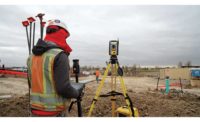Frustrated by the state of sensor platforms for tracking jobsite conditions, Mark Bryant set out to build his own. He reasoned that anyone could cobble together some off-the-shelf sensors, but ingesting all that data and getting useful, actionable information was the real challenge to be overcome.

As chief information officer at Edmonton, Alberta-based PCL Construction, Bryant has long been an advocate for bringing high technology to the jobsite. But construction has a reputation as a technology-adverse industry, and Microsoft engineers working on the Azure Digital Twins cloud-based analytics platform were initially skeptical of Bryant’s proposal. The tech giant had sought other clients for its Internet of Things platform, but Bryant’s ambitious plans intrigued them. “PCL’s use case wasn’t in our realm of thought, we weren’t even thinking of construction. They thought of that themselves,” recalls Julie Morin, solution lead and global black belt for IoT at Microsoft Canada. “They didn’t fit the traditional mold of what we were looking for. [Bryant and his team] used the tech in ways Microsoft had never thought about and built something original—they really were pioneers.”
One of the most time-consuming issues on jobsites is getting up-to-date and accurate information on site conditions and progress. What Bryant and his team at PCL built on top of Microsoft Azure Digital Twins became Job Site Insights, a web-based platform to bring in vast amounts of sensor data and provide a more intelligent view of a jobsite. The system captures data from thousands of sensors measuring temperature, humidity, wind speeds, worker or material locations—anything that can be logged can be aggregated. JSI compares those readings against scheduling and financial data, providing project managers and site supervisors with alerts to problem areas and, eventually, real advice on improving efficiency. JSI is hardware agnostic, built to work with just about any kind of jobsite sensor or data-logging system.
Successfully used on sites such as Los Angeles International Airport and Edmonton’s Stantec Tower, JSI is now a standard tool for PCL. “We’ve already put the entire schedule on a single pane of glass,” says Bryant. “If we marry that to telemetry data from sensors, we can change productivity, safety, all parts of the job. We can change how we do construction, during construction.”
“Mark had a vision for what he wanted,” says Morin. “It extends beyond construction. He’s creating disruption. It’s a real wave in the industry.”






Post a comment to this article
Report Abusive Comment